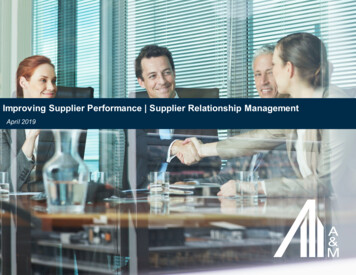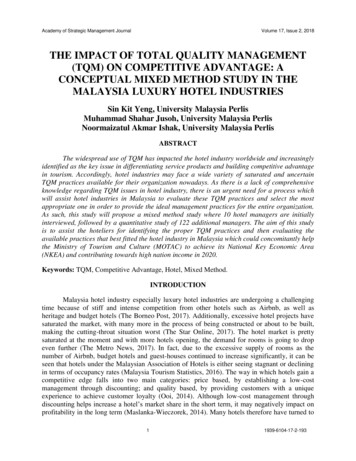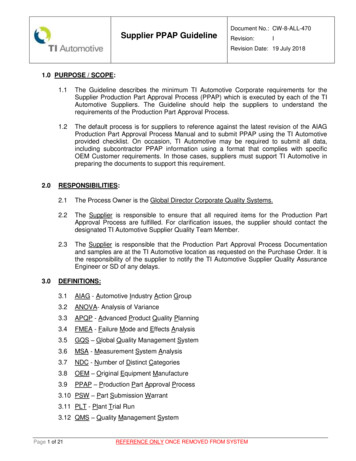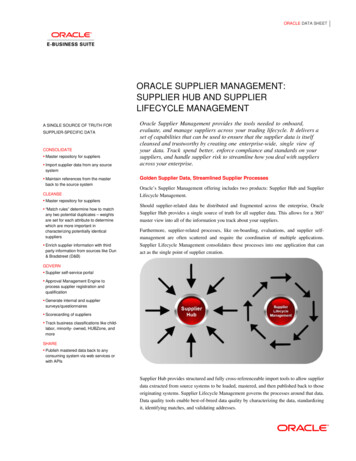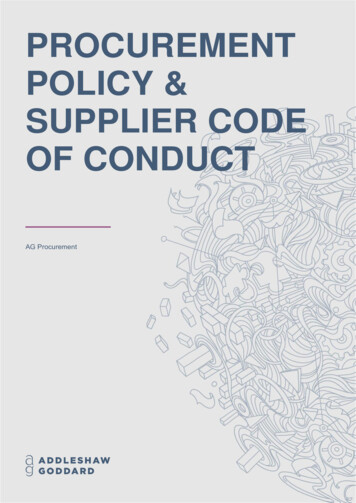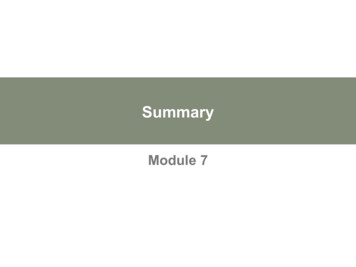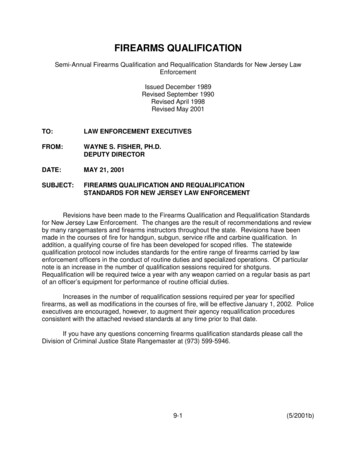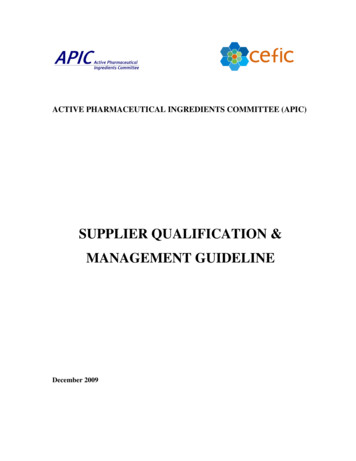
Transcription
ACTIVE PHARMACEUTICAL INGREDIENTS COMMITTEE (APIC)SUPPLIER QUALIFICATION &MANAGEMENT GUIDELINEDecember 2009
Content1. Introduction2. Chapter 1: Supplier Selection3. Chapter 2: Due Diligence4. Chapter 3: Quality Assessment5. Chapter 4: Change Control Production Assessment6.Chapter 5: Supply Chain Security7.Chapter 6: Ongoing Monitoring and Evaluation8.AppendicesAppendix 1:Appendix 2:Appendix 3:Appendix 4:Appendix 5:Examples of Critical/ non Critical Raw MaterialsSupplier Selection Check ListDue Diligence Check ListSupplier QuestionnairesCheck list for Change Control Assessment2
INTRODUCTIONManufacture of Medicinal Products and the Active Pharmaceutical Ingredients (APIs)used as starting materials in the production of these products is subject to strict goodmanufacturing practice regulations that are designed to ensure their quality, safety andefficacy. This ensures that patients worldwide and at any time can have confidence in thequality, safety and efficacy of medicines.The cGMP regulations for final medicinal products are clearly defined in each countryand region. The content of the regulations may vary but the objectives are the same:- To deliver high quality, safe medicines manufactured and distributed followingcontrolled procedures to treat diseases and- To prevent deaths, serious illnesses, adverse events or product recalls resulting fromdeficiencies in the manufacturing and distribution processes.While in the vast majority of cases, the pharmaceutical industry, under the oversight ofthe Regulatory Authorities and inspectorates consistently applies appropriate cGMPpractices, there are many cases known where the standards expected from manufacturingcompanies have not been maintained. Some of these cases had very serious consequencese.g.:The heparin case in 2008, causing around 150 fatalities in the U.S. due todeliberate contamination of the API with a bogus substance (oversulphatedchondroitin sulphate)The many scandals involving the contamination of glycerine with diethyleneglycol that led amongst others to 107 deaths in the USA (1937), around 300deaths in Bangladesh (1990), 88 deaths (young children) in Haiti (1996), and 138deaths in Panama (2006), due to lack of controls in the distribution networks ofglycerine and in the medicinal product manufacturing sites involvedThe gentamicin sulphate case in which unknown contaminants caused in totalaround 65 deaths in the USA in 1994 and 1999 respectivelyOther cases of counterfeit medicines, falsified APIs and medicinal product recallsdue to adulteration of medicines or APIs released to the market underline thepotential magnitude of the risk to patients if the supply chain for medicines is notproperly qualified.In some cases business pressures to reduce costs results in sourcing APIs and the rawmaterials used in their manufacturing process at the lowest cost. While this practice, inand of itself, does not create non-compliance, it does create an opportunity forunscrupulous suppliers to insert themselves into the supply chain and introducesubstandard materials. This situation also highlights the need for clarity regardingexpectations and requirements for supplier quality and assurance of the full supply chain.3
The scope of this guidance document is to share the best practices of APIC membercompanies on systems to be implemented to adequately manage suppliers through thecomplete life cycle of the product, includingSupplier Selection Process based on definition of the User’s Requirements for amaterial with as a minimum a specificationo Sample evaluation including where necessary laboratory and /orproduction trialsDue Diligence process of potential suppliers of critical raw materials, registeredintermediates and APIsQuality Assessment of all suppliersChange control and production assessment as necessarySupply chain securityOngoing monitoring and evaluationThe target audience for the guidance document is primarily API Manufacturers while itmay also be used by medicinal product manufacturers who are primarily responsible toqualify their suppliers / manufacturers of APIs used as Starting Materials in themanufacture of medicinal products.We have classified the materials into the following four categories based on qualitycriticality to the API manufacturing process and on risk related to potential for harm tothe patients:Non-critical raw materialsCritical raw materials (including API Starting Materials)Registered intermediatesAPIs4
The quantity of materials in each category is likely to decrease as the criticality increasesas indicated in the following triangle:Critical Raw MaterialsRegistered IntermediatesIntermediatesAPIsIncreasing Levels of GMPNon critical Raw MaterialsIn terms of defining the categories of materials we recommend that companies review theuse of the material based on the ICH Q7 definition of Critical:“Critical describes a process step, process condition, test requirement, or other relevantparameter or item that must be controlled within predetermined criteria to ensure thatthe API meets its specification”.For an API manufacturing process involving multiple-step synthesis, raw materials usedin the early steps are likely to be less critical than those used in the final API step giventhat accurate specifications will be defined for all raw materials.To assess the risk to patients related to the material we recommend that companies followICH Q9 for their Quality Risk Management process and use the ICH Q9 definition ofRisk:“Risk is the combination of the probability of occurrence of harm and the severity of theharm to the patient or consumer”.For example the risk of particulate or microbiological contamination from a reagent,solvent, water system, utility or primary packaging material that are in direct contact withan API will or greater than materials used earlier in the process.We recommend that suppliers of all the materials should be approved using theCompany’s Change Control Procedures and / or Supplier Approval Procedures. Change5
control requirements would also be more stringent for critical raw materials (includingAPI Starting Materials), registered Intermediates and API and should include aRegulatory Assessment.Definitions:Raw materials can be sub-categorised into three different classes:a. Those that are widely commercially available and are used in multiple industries, forexample acids, bases, solvents, filter aids, petroleum based raw materials, naturallyoccurring raw materials, packaging materials, water systems or utilities in contact withthe API such as nitrogen or compressed air.b. Those that are commercially available for use in the API Industry such as catalysts,enzymes, chemical (including chiral) building blocks.c. API Starting Materials. These may be generally available or involve custom synthesisor specific process development by the supplier before becoming available on anindustrial scale.Registered intermediates usually involve custom synthesis or process developmentby the supplier.APIs will be manufactured under custom synthesis or contract manufacture or will begenerally available if used in the manufacture of off-patent medicinal products.Further examples of types of materials covered by the scope of this guidancedocument and guidance on criticality are given in Appendix 1.Guidance:The quality system requirements to identify, select, approve and qualify suppliers of allmaterials used in the manufacture of APIs and medicinal products are clearly defined inthe GMP Guidelines.Manufacturers of medicinal products, APIs and registered intermediates for APIs areresponsible for approving and qualifying their suppliers and to monitor on an ongoingbasis the performance of their critical suppliers.The Regulatory Agencies will and do inspect the supplier qualification procedures usedby medicinal product manufacturers and expect that they periodically audit their APIsupplier / manufacturer. As part of this audit, the medicinal product manufacturer shouldensure that the API supplier / manufacturer also has supplier qualification procedures inplace for their suppliers of critical and non-critical raw materials, API Starting Materials,Registered Intermediates and APIs (in the case of contract manufacturers). In relation tocritical raw materials the Authorities will also expect a monitoring programme to be in6
place and for the manufacture to have clear oversight of the changes with possible qualityimpact made by their suppliers.Inspectors will also expect that the distribution and supply chains have also beenevaluated and that controls are in place to ensure there is adequate Supply ChainSecurity, to avoid possible fraudulent practices and to ensure that appropriatetransportation conditions (i.e. temperature and humidity) are applied during distributionwhere this is required based on the properties of the materials.The pre-requisites for approval of suppliers of all materials including non critical rawmaterials are that the material meets the specification defined by the customer confirmedby 1) sample evaluation (QC testing) and that 2) there is an evaluation of the qualitysystem in place designed to assure and control the manufacture, testing, release anddistribution of the material.The expected Product Quality Standard and the depth of the quality assessment will varydepending on the type of material but these two pre-requisites should always be there andwould be considered as the basic requirement for approval of a non-critical raw materialsupplier.For critical raw materials, intermediates and API’s, it is recommended there should be adue diligence assessment, a more detailed assessment of the quality system and materialevaluation should involve laboratory or plant trials prior to full production assessment.A purchasing contract that defines quality requirements should be in place for suppliersof all materials and a Quality Agreement should be in place for suppliers of registeredintermediates and APIs.Any changes to the material specification, analytical methods and/or manufacturingprocess that may affect the quality of the material supplied and/or the down streamproducts should be informed in advance (and prior to implementation) to evaluate theimpact on down stream production/product.Our guidance covers supplier management over the entire product lifecycle as describedin the Vendor Management Flow Chart below:7
Vendor Management Across The Life CycleIdentification ofPotential Suppliersbased on SpecsShort ListSupplier SelectionProcessSample Evaluation(if sample isavailable)Go/No Go onShort ListTechnicalReviewData Collectionfrom the suppliersDue DiligenceProcessCross FunctionalVisitRecommendationsGo/No GOSample EvaluationQuality AssessmentRemediation and Assessment of Approval underchange controlYes/NoSigned Quality/ContractAgreementsChange ControlEvaluationProduction &ValidationAssessmentKey to ColourCodesAPI & RegIntermediates andCritical RawMaterials based onRisk AssessmentAll y ChainSecurityOngoingMonitoring &Evaluation8
The main steps of Supplier Management are described in each chapter including theelements relevant for non critical or critical raw materials, registered intermediates orAPI’s.We are also referring to existing APIC guidance documents whenever applicable tofurther clarify expectations and provide consistency to the processes. e.g.:- Quality Agreements- Auditing Guide,- APIC Audit Programme- APIC Quick Guide for API Sourcing- APIC ICHQ7 How to do Document- APIC Quality Management System Guide for API manufacturersThose documents are available on the APIC website: WWW. APIC.CEFIC.ORGIn the appendices we also provide specific assessment documents as examples to helpwith supplier evaluation based on best practice sharing by the Task Force members listedbelow:- Bryson Lynn (JOHNSON MATTHEY MACFARLAN SMITH)- Buggy Tom (DSM ANTI-INFECTIVES)- Stilgenbauer-Voigt Ingrid (BASF)- Chekatt Habiba (DSM NUTRITIONAL PRODUCTS)- Hamrin Pia (DSM NUTRITIONAL PRODUCTS)- Vandeweyer François (JANSSEN PHARMACEUTICA)- Stampfli Claudia (LONZA)- Cox Robert (LONZA)- Counihan Eileen, Chair (MERCK SHARP & DOHME)- Vandenbossche Claude (AJINOMOTO OMNICHEM)- Storey Anthony (PFIZER)We have had a lot of fun and enjoyed working together and sharing best practice in thecreation of this document. We hope you will find it useful in the serious business ofsupplier management and the assurance of safe APIs and medicines for the health, safetyand quality of life of our patients worldwide.If you have any comments or suggestions for improvement please contact the APICSecretary at:CEFICActive Pharmaceutical Ingredients Committee (APIC)Av. E. Van Nieuwenhuyse 4 / box 2B - 1160 BrusselsTel : 32 2 676 72 02 or 32 2 676 72 44 - Fax : 32 2 676 73 59E-mail : pvd@cefic.be or abo@cefic.beFor further details on APIC and for other APIC Guidances see: www.apic.cefic.org9
CHAPTER 1. SUPPLIER SELECTIONThe purpose of this step is to define a set of criteria that can be taken into consideration inthe selection process of a supplier. If a supply need is identified purchasing is contactedfor the identification of (a) potential supplier(s). The supplier selection process starts withthe definition of the user requirements for the materials(s) within scope.The user requirement specifications provided to purchasing should contain as a minimumthe following information: Name of the product (including formulae and CAS number when available) Material specifications Quantity requiredThe materials within scope of this guidance have been classified as follows: Non-critical raw materials, Critical raw materials (including API starting materials); Registered intermediates; APIsFor the raw material group a sub-categorisation into three different classes is proposed. Those that are widely commercially available and are used in multiple industries, forexample acids, bases, solvents, filter aids, petroleum based raw materials, naturallyoccurring raw materials, packaging materials, water systems or utilities in contact withthe API such as nitrogen or compressed air. Those that are commercially available but are for use in the API Industry such ascatalysts, enzymes, chemical (including chiral) building blocks. API Starting Materials. These may be generally available or involve custom synthesisor specific process development by the supplier before becoming available on anindustrial scale.The quality system evaluation may be less or more elaborate in function of the identifiedmaterial classes and follows a documented process. The following information from thesupplier should be requested as part of the Suppliers Questionnaire (As per Appendix 4) :- Specifications- Manufacturing/packaging/labelling details- Materials Safety Data Sheets- Logistic information (lead time to produce, delivery time, etc)- Certificates regarding Quality system, residual solvents, etc.- BSE/TSE evaluation-Analytical test methodIt is a pre-requisite to demonstrate that the material provided by the potential suppliermeets the specification as defined, and compliance to the specifications should beverified by analytical testing of a sample. The sample (representative of commercialproduction) can be pre-shipment sample(s) (with appropriate controls) or the releasesample of the first delivery.10
For critical raw materials, intermediates and APIs it is likely that the data to be requestedand collected from the potential suppliers will be more elaborate comprehensive than forraw materials.For critical raw materials, registered intermediates and APIs key selection criteria havebeen identified and categorised.Following different dimensions could be assessed:- Assurance of Supply,- Quality & Regulatory compliance;- Cost/Procurement aspects;- Technical/Innovation;- Communication capabilities & responsivenessThe Supplier Selection Checklist (Appendix 2) contains a non-exhaustive list of areas toaddress which must be requested from the supplier. The Supplier selection checklistshould be seen as an example and should be adopted in function of the company’s need.Some of the identified criteria can also be considered in the selection process for noncritical raw materials. A suggestion of topics to be checked for non critical raw materialsis provided in Appendix 2.Each different criteria is discussed in more detail below:1. Assurance of SupplyAssurance of supply is an essential element in order to guarantee appropriate supplychain management in the organisation. To obtain a picture as complete as possiblefollowing aspects should be taken into consideration: Capacity (Scale equipment, batch size, chemistry experience, etc. ) Safety/Health/Environmental Risk Inventory management Financial solvency/business stability REACH requirements Delivery performance Supply chain management of the material in question2. Quality & Regulatory ComplianceIn the selection process it is essential to take the quality and regulatory track recordhistory into account. To obtain a comprehensive picture of the supplier's compliancestatus, the following aspects should be taken into consideration: cGMP Compliance & regulatory track record Recalls & Complaints Change/Deviation Management Materials management controls11
Quality Management SystemsQuality AgreementQuality CultureProduction Facilities & EquipmentProduct Quality ReviewProcess Validation approach:QOTIF % (On time in Full)Documentation standard3. Procurement/CostNext to the price of the material within scope there are other aspects related to cost andprocurement that should be taken into consideration: Cost Management (Cost visibility) Presence in Low Cost Countries (Emerging markets) Ability to achieve the target price4. Innovation/TechnicalIn order to generate a better understanding of the technical competences and innovativeprofile of the supplier, following aspects should be taken into consideration:o Technology specialismo Plant capabilitieso Laboratory capabilitieso Business problems resolving capabilitieso Technical skills/ Staff Qualificationso Control systemso Development capabilityo Process development expertiseo Project managemento Willingness to innovateo Intellectual property5. Responsiveness & CommunicationIn order to generate a better view on the responsiveness and communication capabilities,following aspects should be taken into consideration:oooooooRapidity project assessmentResource availabilityFlexibility (Attitude)Functional contacts definitionOpennessEase of communication (understanding of English)Pro-activeness12
For critical raw materials, registered intermediates and APIs all data collated from thepotential suppliers is assessed thoroughly ideally by a multidisciplinary team. Thisassessment should result in a shortlist of potential suppliers. In case material sampleswere received the analytical test results generated are used to support the GO/NO GOdecision to pursue the supplier qualification process of the identified supplier. The nextstep is to initiate the due diligence procedure. This will allow the company to compiledocumented evidence of the supplier's suitability. Further guidance on the due diligenceprocedure is provided in Chapter 2.For non critical raw materials meeting the defined user requirements a quality assessmentis started to determine the suitability of the supplier. A positive outcome of the qualityassessment is required to continue progressing with the supplier. Further guidance onhow to conduct the Quality Assessment is provided in Chapter 3.13
CHAPTER 2. DUE DILIGENCEPurpose:This chapter is not applicable for non-critical raw materials.For Critical Raw Materials including API Starting Materials the necessity toperform a due diligence can be based on a risk assessment according to ICH Q9.This chapter will define and provide detail to assure that the appropriate duediligence is conducted prior to contracting with the supplier. Documentedevidence will be assembled to support the Go/No Go decision process.The possibility of establishing a long term business relationship with the supplierwill be evaluated.The implemented systems and existing facility will be assessed and challenged inorder to evaluate the capability of the supplier to comply with the customer’srequirements.The potential to supply where process is not yet established and samples /production batches are not available/ produced will also be assessed based oncapabilities for example:o process equipment ,o facility containment,o quality of utilities,o analytical equipment availability including stability chamberso potential for process and analytical method development and validationo ability / demonstrated performance of preparing regulatory submissions1. Selection of cross functional team:Depending on a criticality evaluation a cross functional team will be formed.Representatives of the Project Management, Procurement and the Quality Unit willalways be part of the due diligence team. Resulting from the criticality evaluation theteam can be extended with representatives from other areas such as:- Engineering,- Regulatory,- Environmental/ Health / Safety,- Technical Experts e.g. Chemical/Biological Process Engineer(s) and QBDexperts,-Procurement,Each member of the due diligence team documents the collected information andformulates a decision and/or action proposal related to his/her expertise field. Thecombined information is presented to the Senior Management in the form of arecommendation.14
2. Areas to be challenged:2.1. General Material Information:The general material information to be challenged can be based on sample evaluationresults where available, possible impurity profile issues, quality system pre-assessmentand/or supply chain assurance. Examples to verify are:Sufficient capacity to assure supply chain,Anti Counterfeiting measurements,Audit sustainability (qualification of the total supply chain),The most important items to challenge related to the general material information arelisted in Appendix 3 Due Diligence Check List.2.2. Quality Systems:ICH Q7 must be used as basis to evaluate the implemented quality systems for RegisteredIntermediates and API’s.If for Critical Raw Materials including API Starting Materials, the outcome of a riskassessment according to ICH Q9 indicates the necessity to perform a due diligence, thefocus of the evaluation of the quality systems implemented can be reduced according tothe requirements indicated by the risk assessment.If ICH Q7 is not applicable the General Quality System in place (example ISO 9001)should be challenged.Additional to compliance to ICH Q7 other topics can be challenged. Examples are:Use of Quality By Design,Implementation of systems to assure Continuous Quality Improvement,Implementation and use of Risk Management2. 3. Plant Tour / OrganizationA plant tour contributes to the evaluation of the ability and willingness of themanagement to support facility and equipment maintenance andcontamination prevention.Examples of items to be challenged during the plant tour are:Contamination prevention,Utilities: Water system, HVAC, Nitrogen, Steam, Cool media,Equipment calibration and maintenance (production and QC),Laboratory controls and product release proceduresWarehouse controls15
2.4. Documentation / OrganizationThe documentation review contributes to the evaluation of capability of the organizationto demonstrate traceability, compliance to the manufacturing process and compliance toICH Q7 and/or the General Quality System in place.Examples of documentation that can be challenged during review are:master records, batch production records, laboratory recordsTraining and personnel qualification,Quality systems (product release, change control, deviation handling, failureinvestigations, stability program, etc.).2.5. ProcessEvaluation of the process and equipment availability contributes to the evaluation of thecapability of the company to manufacture material of consistent quality and compliant toICH Q7 if applicable (examples: API and registered intermediates) or compliant to theGeneral Quality System in place.2.5.1. Chemical Synthesis.Examples of items that can be assessed are:Critical process parameters and their associated critical quality attributesidentified,Chemical development history/report,2.5.2. Bio Chemical Synthesis.Examples of items that can be assessed are:Cultivation Process,Purification Process,Cell bank maintenance,2.5.3. Manufacturing process (Chemical and Biological):Examples of items that can be assessed are:Process trending (Yield, Quality, etc.),Rework / ReprocessValidation protocols and reports,2. 6. Physical Properties of the materialEvaluation of the consistency of the Physical Chemistry of the material contributes to theevaluation of the manufacturability of the material in next process steps.16
Examples of Physical properties can be assessed are:Solubility profile,Polymorphism, documentation on most stable polymorph,Particle sizeDegradates2. 7. Analytics & StabilityEvaluation of the analytical and stability results contributes to the evaluation of theconsistency of the quality of the material, its quality profile and accuracy of implementedstorage conditions.Examples of items that can be assessed are:Stability indicating methods,Analytical methods validatedPharmacopeia methods are verified,Specifications and technical justification,Product Quality Reviews2. 8. Regulatory:Evaluation of the regulatory status and documentation contributes to the evaluation of thecompliance status of the material for all intended countries.2.9. Economics:Evaluation of the economic contribution to the decision process related to the location ofthe manufacturing site, supply chain, and business continuity assurance:2.10. Intellectual PropertyEvaluation of the patent situation, as well for the production process as the manufacturingtechnologies used contributes to the decision process.2.11. Safety, Environment & HealthEvaluation of the safety, environment & health systems implemented contributes to theevaluation of the ability and willingness of the management to assure compliance to localauthorities' requirements and people health protection as part of the decision process.Examples of items that can be challenged are:Industrial Hygiene aspects,Child labourSynthesis steps with extreme conditions (temperature, pressure, reagents),Waste Management Licences and SHE Quality Systems such as ISO 1400117
3. Conclusion/Outcome:An overall report will be issued by the team. The combined information must be used toformulate a final recommendation to Senior Management.If critical issues (Quality, Safety, Health, Environment, Regulatory, Business continuity)are identified and do not have a clearly defined actions for remediation, this informationmust be escalated to Senior Management.If Critical Quality and GMP issues are identified an accurate and approved mitigationplan must be available before the Quality Audit will be executed.Senior Management is responsible for the final Go/No-Go decision.18
CHAPTER 3. QUALITY ASSESSMENTA summary of the quality assessment procedure is outlined in table 1 for the threecategories of materials.Table 1: Summary of Quality Assessment ProcedureRequirementNon Critical RawmaterialCritical RawmaterialRegisteredIntermediate/APITSE/BSE Assessment ** Tanker Cleaning cturer AuditHistorical Performance*** ** cGMP Compliance History rd3 party certification*** ** ** Contract AgreementQuality Agreement*(if available) - Required** - Dependant on risk assessment performed on material being purchased.1. Format of the Quality AssessmentThe format of the quality assessment is dependant on the criticality of the raw materialbeing purchased and the outcome of risk assessment being performed on the material.Non critical Raw MaterialsFor non-critical materials the quality assessment may be limited to a core section of thesupplier questionnaire as outlined in Appendix 4 and/or the provision of an ISO9001:2008 or equivalent certificate and/or satisfactory past performance by the supplier.The level of assessment is ultimately a decision based on a documented risk assessment.19
Critical Raw MaterialsThe level of quality assessment is based on risk assessment which will take into accountthe level of in house analysis the customer intends to perform.In some circumstances, depending on the supply relationship, the customer can use thesuppliers evaluation procedures for the manufacturer, as long as this is documented aspart of their (the customers) supplier evaluation procedure.If the customer intends to implement reduced testing of the material it is recommendedthat the quality assessment takes the form of a manufacturer questionnaire or for“critical” raw materials a manufacturer audit. This decision is again risk based. Anexample of a full scope of a manufacturer questionnaire is outlined in Appendix 4.Registered Intermediates and API’sFor registered intermediates and API’s a quality audit of the manufacturer isrecommended as a key part of the quality assessment.2. General ConsiderationsThe following must be addressed in the quality assessment of all raw materials/ registeredintermediates and API’s:TSE/BSE AssessmentThe supplier must be able to certify that all raw materials/ source materials and any othermaterials (i.e. cleaning agents) used at any stage of the production process comply withthe “Note for guidance on minimising the risk of Transmitting Animal SpongiformEncephalopathy Agents via Medicinal Products”- EMEA/410/01 (TSE Guideline).Materials delivered in tankersWhen dealing with material which is to be delivered in tankers the quality assessmentmust address if the tanker is dedicated to one material and if not, cleaning verificationprocedures must be consid
SUPPLIER QUALIFICATION & MANAGEMENT GUIDELINE December 2009. 2 Content 1. Introduction 2. Chapter 1: Supplier Selection . there are many cases known where the standards expected from manufacturing . Ap p ro va l u n d e r c h a n g e c o n tro l Ye s /No C h a n g e C o n tro l E va lu a tio n

